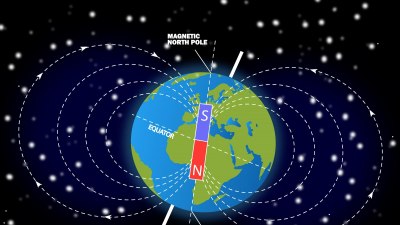How Weather Influences Earth’s Magnetosphere
Explore the intricate relationship between weather and Earth's magnetosphere, including solar influences and space weather.

Image by kajacyprichova8 on Freepik
The relationship between weather and Earth's magnetosphere is profound and complex, involving a multitude of factors from both terrestrial and celestial realms. Understanding how these elements interact is crucial for grasping the broader implications for climate science, technology, and even human health.
Earth’s magnetosphere is a vast region of space around our planet, dominated by Earth’s magnetic field. It protects us from solar winds and cosmic radiation, serving as a shield that deflects charged particles emitted by the sun. However, this magnetic barrier is not static; it is constantly influenced by a range of factors, including atmospheric conditions, solar activity, and geomagnetic phenomena.
Solar Activity and its Influence on the Magnetosphere
One of the most significant contributors to changes in the magnetosphere is solar activity, particularly the solar wind. The sun continuously emits charged particles, forming solar wind, a stream of particles that can interact with the Earth’s magnetic field. During solar storms, particularly during periods of increased solar activity like solar flares and coronal mass ejections (CMEs), this wind can become more intense, impacting the magnetosphere severely.
These interactions can lead to magnetic storms, which are disturbances within the magnetosphere. These storms can influence satellites' operations, radio communications, and even power grids on the Earth’s surface. For example, in 1989, a geomagnetic storm caused a blackout in Quebec, Canada, demonstrating the real-world consequences of solar influence on our planet's magnetosphere.
Atmospheric Weather Patterns
Apart from solar activity, terrestrial weather patterns also exhibit interactions with the magnetosphere. The Earth’s atmosphere and magnetic field work together, creating conditions that can either shelter or exacerbate the effects of solar wind. For example, low-pressure systems can create disturbances in the atmosphere, while high-pressure systems can lead to clearer skies and lower levels of atmospheric noise, which may enhance the magnetosphere's protective effects.
During severe weather events, such as hurricanes or thunderstorms, the complexity of atmospheric interactions with the magnetosphere increases. These events can generate large electrical currents in the atmosphere, which may, in turn, influence the geomagnetic field. Research suggests that such phenomena could alter the distribution and intensity of charged particles within the magnetosphere.
The Role of Space Weather
Space weather, a term used to describe the environmental conditions in space as influenced by the sun, plays a pivotal role in our understanding of the magnetosphere. Variations in solar wind speed and density can lead to changes in the magnetosphere's shape and size, as it expands and contracts in response to these incoming solar particles.
Furthermore, space weather impacts Earth’s upper atmosphere, influencing phenomena such as the auroras observed at polar regions. These stunning light displays occur when charged particles from solar wind collide with atoms in the Earth’s atmosphere, leading to ionization and energy release. Thus, the weather on Earth is intrinsically linked to the weather in space, each affecting the other in complex ways.
Geomagnetic Reversals and Climate Change
Beyond daily weather, understanding how the magnetosphere functions on timescales of thousands to millions of years adds another layer to the relationship between weather and the magnetosphere. Geomagnetic reversals, where the magnetic north and south poles switch places, can impact Earth’s surface conditions but are largely independent of terrestrial weather.
However, these long-term changes can influence the overall climate system, potentially leading to shifts in global temperatures and atmospheric conditions. For instance, some studies suggest that during periods of weak magnetic protection, the Earth may experience an uptick in cosmic radiation, influencing climate conditions potentially linked to periods of warmer climate phases.
Implications for Technology and Daily Life
As our reliance on technology continues to grow, understanding the interplay between weather and the magnetosphere becomes increasingly critical, especially in areas like aviation and satellite operations. During periods of heightened solar activity, airlines may reroute flights over polar regions due to increased radiation exposure poses potential risks to passengers and crews.
Satellites are also affected by space weather; a geomagnetic storm can result in disruptions ranging from decreased satellite performance to the potential for complete operational failure. Consequently, monitoring space weather is vital for protecting infrastructure and ensuring the safety of operations that depend on satellite technologies.
Advancements in Monitoring and Research
The advancements in technology and scientific understanding have significantly enhanced our capacity to monitor both terrestrial weather systems and space weather. Satellites equipped with sophisticated instruments provide real-time data on solar activity and its impact on the magnetosphere. Researchers can now analyze data streams that detail solar emissions, magnetic field fluctuations, and consequent atmospheric interactions. This information is pivotal for developing more accurate predictive models, enhancing our ability to respond to potential disruptions associated with severe weather events in both the atmosphere and space.
Moreover, collaborations between various scientific organizations across the globe are leading to more refined objectives, focusing on understanding the relationship between weather and the magnetosphere in greater depth. Multidisciplinary teams are integrating meteorological models with space weather data, improving predictive capabilities and risk assessments for potential disruptions to activities dependent on satellite technology.
Conclusion
The intricate interplay between weather and Earth’s magnetosphere exemplifies the interconnectedness of terrestrial and celestial systems. As we navigate the challenges posed by both atmospheric and space weather, understanding these dynamic relationships becomes ever more essential. Ongoing research and advancements in technology will undoubtedly shape our ability to predict and mitigate the effects of these systems, allowing us to protect our technological infrastructures and enhance our understanding of Earth’s complex climatic and magnetic interplay.











